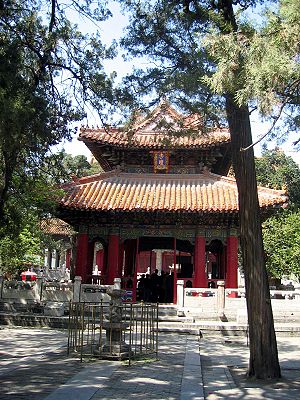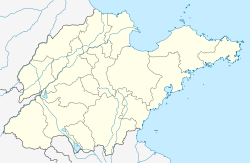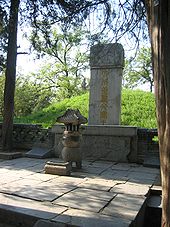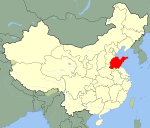- Qufu
-
Qufu
曲阜— County-level city — 曲阜市 Qufu's south gate Location in Shandong Coordinates: 35°36′N 117°02′E / 35.6°N 117.033°ECoordinates: 35°36′N 117°02′E / 35.6°N 117.033°E Country People's Republic of China Province Shandong Prefecture-level city Jining Township-level divisions Elevation 65 m (214 ft) Time zone China Standard (UTC+8) Qufu (Chinese: 曲阜; pinyin: Qūfù; Wade–Giles: Ch'ü1-fu4) is a city in southwestern Shandong province, People's Republic of China. It is located at 35° 36′ northern latitude and 117° 02′ east, about 130 kilometres (81 mi) south of the provincial capital Jinan and 45 kilometres (28 mi) northeast of the prefecture seat at Jining. Qufu has an urban population of about 60,000, the entire administrative region has about 650,000 inhabitants.
Qufu is the hometown of Confucius, who is traditionally believed to have been born at the nearby Mount Ni. The city contains numerous historic palaces, temples and cemeteries. The three most famous cultural sites of the city, collectively known as San Kong (三孔), i.e. "The Three Confucian [sites]", are the Temple of Confucius (Chinese: 孔庙; pinyin: Kǒngmiào), the Cemetery of Confucius (Chinese: 孔林; pinyin: Kǒnglín), and the Kong Family Mansion (Chinese: 孔府; pinyin: Kǒngfǔ). Together, these three sites have been listed as a UNESCO World Heritage Site since 1994.
Contents
History
Temple and Cemetery of Confucius and the Kong Family Mansion in Qufu * UNESCO World Heritage Site
Country  People's Republic of China
People's Republic of ChinaType Cultural Criteria i, iv, vi Reference 704 Region ** Asia-Pacific Inscription history Inscription 1994 (18th Session) * Name as inscribed on World Heritage List
** Region as classified by UNESCOQufu served as the capital of the State of Lu during the Spring and Autumn Period. The city wall of the Lu capital surrounded not only the area of today's (Ming-era) walled city, but also a significant territory to the east and north of it.
During the Tang Dynasty and the early days of the Song Dynasty the city was centered around the present-day Temple of Duke Zhou, at the northeastern corner of today's walled city. At 1012, Qufu was renamed to Xianyuan County (仙源县), and relocated to the new site, some 4 km east of today's walled city, next to the supposed birthplace of the legendary Yellow Emperor and the tomb of his son Shaohao. A temple in honor of the Yellow Emperor was built there; all that remains today are two giant stelae (the Shou Qiu site).[1]
After the conquest of the northern China by the Jurchens, the new Jin Dynasty renamed Xianyuan back to Qufu (in 1142), but the city stayed at its Song location. It was not until the reign of the Jiajing Emperor of the Ming Dynasty (1522) that the present-day city wall was built. The site of the city in 1012-1522 is now Jiuxian Village (旧县村).[1]
In 1948, Qufu played a minor role in the Yanzhou Campaign of the Chinese Civil War.
The artifacts of the historical sites at Qufu suffered extensive damage during the Cultural Revolution when about 200 staff members and students of Beijing Normal University led by Tan Houlan (谭厚兰, 1937–1982), one of the five most powerful student leaders of the Cultural Revolution, came to Qufu and destroyed more than 6000 artifacts in November 1966.[2][3][4]
Before the wide adoption of Pinyin, the name of the city (often viewed as a county seat, i.e. Qufu xian) was transcribed in English in a variety of ways, such as Ch'ü-fou-hien,[5] Kio-feu-hien,[6] Kio-fou-hien,[6] Kiu-fu,[7] Kiuh Fow, Keuhfow, Kufow, and Chufou.[8]
Geography
The small historical center of Qufu is surrounded by the restored Ming-era city wall and rivers/moats. The Drum Tower (Gulou) is in the center of the walled city; the Temple of Confucius (Kong Miao), Confucius Mansion (Kong Fu) and the Temple of Yan Hui (Yan Miao) occupy large sections of the land within the wall.[9]
The Confucius Cemetery (Kong Lin) is located 1.3 km to the north of the walled city. The modern downtown is located south of the walled city. There is also a mosque and a thriving Muslim neighborhood and market that is located just outside the west gate of the walled city.
The Qufu train station and major industrial areas are on the east side, a few kilometers east of the historical city. The Shaohao Tomb (Chinese: 少昊陵; pinyin: Shǎohào Líng) and Shou Qiu historical site (Chinese: 寿丘; pinyin: Shòu Qiū, the purported birthplace of the legendary Yellow Emperor, are on the eastern outskirts of the modern Qufu as well, near Jiuxian village.
Temple of Confucius (Kong Miao)
Main article: Temple of Confucius, QufuWithin two years after the death of Confucius, his former house in Qufu was already consecrated as a temple by the Prince of Lu. In 205 BC, Emperor Gao of the Han Dynasty was the first emperor to offer sacrifices to the memory of Confucius in Qufu. He set an example for many emperors and high officials to follow. Later, emperors would visit Qufu after their enthronement or on important occasions such as a successful war. In total, 12 different emperors paid 20 personal visits to Qufu to worship Confucius. About 100 others sent their deputies for 196 official visits. The original three-room house of Confucius was removed from the temple complex during a rebuilding undertaken in 611 AD. In 1012 and in 1094, during the Song Dynasty, the temple was extended into a design with three sections and four courtyards, around which eventually more than 400 rooms were arranged. Fire and vandalism destroyed the temple in 1214, during the Jin Dynasty. It was restored to its former extent by the year 1302 during the Yuan Dynasty. Shortly thereafter, in 1331, the temple was framed in an enclosure wall modelled on the Imperial palace. After another devastation by fire in 1499, the temple was finally restored to its present scale. In 1724, yet another fire destroyed the main hall and the sculptures it contained. The subsequent restoration was completed in 1730. The replacement sculptures were destroyed during the cultural revolution in 1966. In total, the Temple of Confucius has undergone 15 major renovations, 31 large repairs, and numerous small building measures.
The temple complex is the second largest historical building complex in China (after the Forbidden City), it covers an area of 16,000 square metres and has a total of 460 rooms. Because the last major redesign following the fire in 1499 took place shortly after the building of the Forbidden City in the Ming Dynasty, the architecture of the Temple of Confucius resembles that of the Forbidden City in many ways. The main part of the temple consists of 9 courtyards arranged on a central axis, which is oriented in the north-south direction and is 1.3 km in length. The first three courtyards have small gates and are planted with tall pine trees, they serve an introductory function. The first (southernmost) gate is named "Lingxing Gate" after a star in the Great Bear constellation, the name suggests that Confucius is a star from heaven. The buildings in the remaining courtyards form the heart of the complex. They are impressive structures with yellow roof-tiles (otherwise reserved for the emperor) and red-painted walls, they are surrounded by dark-green pine trees to create a color contrast with complementary colors. The main buildings are the Stele Pavilions (e.g., Jin and Yuan Dynasties, 1115–1368), the Kuiwen Hall (built in 1018, restored in 1504 during the Ming Dynasty and in 1985), the Xing Tan Pavilion (simplified Chinese: 杏坛; traditional Chinese: 杏壇; pinyin: Xìng Tán, Apricot Platform), the De Mu Tian Di Arch, the Dacheng Hall (built in the Qing Dynasty), and the Hall of Confucius' Wife. The Dacheng Hall (Chinese: 大成殿; pinyin: Dàchéng diàn, Great Perfection Hall) is the architectural center of the present day complex. The hall covers an area of 54 by 34 m and stands slightly less than 32 m tall.
It is supported by 28 richly decorated pillars, each 6 m high and 0.8 m in diameter and carved in one piece out of local rock. The 10 columns on the front side of the hall are decorated with coiled dragons. It is said that these columns were covered during visits by the emperor in order not to arouse his envy. Dacheng Hall served as the principal place for offering sacrifices to the memory of Confucius. In the center of the courtyard in front of Dacheng Hall stands the "Apricot Platform", which commemorates Confucius teaching his students under an apricot tree. Each year at Qufu and at many other Confucian temples a ceremony is held on September 28 to commemorate Confucius' birthday. (see external links below)
Cemetery of Confucius (Kong Lin)
Main article: Cemetery of ConfuciusThe Cemetery of Confucius (孔林; pinyin: Kǒng Lín) lies to the north of the town of Qufu. The oldest graves found in this location date back to the Zhou Dynasty. The original tomb erected here in memory of Confucius on the bank of the Sishui River had the shape of an axe. In addition, it had a brick platform for sacrifices. The present-day tomb is a cone-shaped hill. Tombs for the descendants of Confucius and additional stela to commemorate him were soon added around Confucius' tomb.
Since Confucius' descendants were conferred noble titles and were given imperial princesses as wives, many of the tombs in the cemetery show the status symbols of noblemen. Tombstones came in use during the Han Dynasty, today, there are about 3,600 tombstones dating from the Song, Yuan, Ming and Qing dynasties still standing in the cemetery.
In 1331 construction work began on the wall and gate of the cemetery. In total, the cemetery has undergone 13 renovations and extensions. Eventually, by the late 18th century, the perimeter wall reached a length of 7.5 km, enclosing an area of 3.6 square kilometers. In this space, the tombs of more than 100,000 descendants of Confucius, who have been buried there over a period of about 2000 years, can be found. The oldest graves date back to the Zhou Dynasty, the most recent of which belong to descendants in the 76th and 78th generation.
The corpse of the duke of Qufu in the 76th was removed from its grave and hung naked from a tree in front of the palace during the desecration of the cemetery in the cultural revolution.[10]
More than 10,000 mature trees give the cemetery a forest-like appearance. A road runs from the north gate of Qufu to the exterior gate of the cemetery in a straight line. It is 1266 m in length and lined by cypresses and pine trees. Along this road lies the Yan Temple, dedicated to Confucius' favorite student.
Kong Family Mansion (Kong Fu)
The direct descendants of Confucius lived in the Kong family Mansion (孔府; pinyin: Kǒng Fǔ) located to the east of the temple. They were in charge of tending to the temple and cemetery. In particular, they were in charge of conducting elaborate religious ceremonies on occasions such as plantings, harvests, honoring the dead, and birthdays. The Kong family was in control of the largest private rural estate in China. The first mansion was built in 1038 during the Song dynasty and was originally connected directly to the temple. During a rebuilding in 1377 directed by the first Ming dynasty Emperor, it was moved a short distance away from the temple. In 1503, it was expanded into three rows of buildings with 560 rooms and - like the Confucius Temple - 9 courtyards. The mansion underwent a complete renovation in 1838 only to perish in a fire 47 years later in 1887. It was rebuilt two years later; the cost of both 19th century renovations was covered by the Emperor. Today, the mansion comprises 152 buildings with 480 rooms, which cover an area of 12,470 square metres (134,200 sq ft). Its tallest structure is the 4-story refuge tower (Chinese: 避难楼; pinyin: Bìnán Lóu) that was designed as a shelter during an attack but was never used. The family mansion was inhabited by descendants of Confucius until 1937, when Confucius' descendant in the 76th and 77th generations fled to Chongqing during the Second Sino-Japanese War and later during the Chinese Civil War to Taiwan, where the head of the family still resides.
The layout of the mansion is traditionally Chinese, it separates official rooms in the front from the residential quarters in the rear. Furthermore, the spatial distribution of the buildings according to the seniority, gender, and status of their inhabitants reflects the Confucian principle of order and hierarchy: The most senior descendant of Confucius took up residence in the central of the three main buildings; his younger brother occupied the Yi Gun hall to the east.
The Five Strange objects are one of the main attractions of the Confucian Mansion
- The strange couplet
- The strange picture
- The strange beast
- The strange tree
- The strange monument
Each of these has a particularly unusual feature about them.
Gallery
- The Temple of Confucius
- The Temple of Yan Hui
-
Stele in memory of rebuilding the temple, Year 9 of Zhizheng era (1349)
-
Stele in memory of rebuilding the temple, Year 6 of Zhengtong era (1441)
-
Stele in memory of rebuilding the temple, Year 4 of Zhengde era (1509)
- The Cemetery of Confucius
- Other sights
See also
- Mount Ni, traditionally believed to be the site of the birth of Confucius
- Zoucheng, hometown of Mencius
External links
- Qufu travel guide from Wikitravel
- UNESCO World Heritage Listing
- CCTV
- Qufu Normal University
- Asian Historical Architecture: Qufu
- qufu.pomosa.com: Extensive photos from 2004
- Panoramic photo of Confucius Temple
- Photographs of a Confucian Temple ceremony
- Confucian website
- A photo tour of Qufu from 2008
Notes
- ^ a b Bo Chonglan et al (2002), p. 109
- ^ "Cultural revolution in Current Events". Weekly Reader Corp.. September 29, 2006. http://www.encyclopedia.com/doc/1G1-153095655.html. Retrieved 2007-03-04.
- ^ Wang Liang, "The Confucius Temple Tragedy of the Cultural Revolution," in Thomas A. Wilson, ed., On Sacred Grounds, (Cambridge: Harvard University Press, 2002)
- ^ Sang Ye and Geremie R. Barmé (2009): The Fate of the Confucius Temple, the Kong Mansion and Kong Cemetery, China Heritage Quarterly, No. 20, December 2009
- ^ Armstrong, Alexander (1896), In a mule litter to the tomb of Confucius, J. Nisbet, http://books.google.com/books?id=2b9FAAAAIAAJ
- ^ a b Legge, James (1867). Confucius and the Chinese classics. pp. 384, 388. http://books.google.com/books?id=9xthAAAAMAAJ&pg=PA384. - Rev. A. Williamson's account of his visit to Qufu in 1865
- ^ Markham (1870), "Journey through Shantung", The journal of the Royal Geographical Society of London (J. Murray) 40: 223, http://books.google.com/books?id=9kM9AAAAYAAJ&pg=PA223
- ^ Colby, Frank Moore; Williams, Talcott, eds. (1918), The New international encyclopædia, Volume 13 (2 ed.), Dodd, Mead and company, p. 276, http://books.google.com/books?id=fmwNAQAAMAAJ&pg=PA276
- ^ See e.g. the map (Fig. 3.1.2.2) in: Schinz, Alfred (1996), The magic square: cities in ancient China, Edition Axel Menges, p. 116, ISBN 3930698021, http://books.google.com/books?id=qhcRYkz-I3YC&pg=PA116
- ^ Jeni Hung (April 5, 2003). "Children of confucius". The Spectator. http://www.findarticles.com/p/articles/mi_qa3724/is_200304/ai_n9228762. Retrieved 2007-03-04.
References
- 傅崇兰 (Bo Chonglan); 孟祥才 (Meng Xiangcai); 曲英杰 (Qu Yingjie); 吴承照 (Wu Chengzhao) (2002), 曲阜庙城与中国儒学 (Qufu's temples and walled cities and China's Confucianism), Zhongguo Shehui Kexue Chubanshe, ISBN 7-5004-3527-4
World Heritage Sites in China East Classical Gardens of Suzhou · Fujian Tulou · Lushan National Park · Mount Huang (Huangshan) · Mount Sanqing (Sanqingshan) · Mount Tai (Taishan) · Mount Wuyi (Wuyishan) · Temple and Cemetery of Confucius and Kong Family Mansion, Qufu · Ancient villages in Southern Anhui - Xidi and Hongcun · West Lake Cultural Landscape of Hangzhou
South Central Ancient Building Complex in the Wudang Mountains · Historic Centre of Macau · Kaiping Diaolou and Villages · Longmen Grottoes · Historic Monuments of Dengfeng, including the Shaolin Monastery and Gaocheng Observatory · Wulingyuan Scenic and Historic Interest Area · Yin Xu
Southwest Dazu Rock Carvings · Historic Ensemble of the Potala Palace, including the Jokhang and Norbulingka · Huanglong Scenic and Historic Interest Area · Jiuzhaigou Valley Scenic and Historic Interest Area · Old Town of Lijiang · Mount Emei Scenic Area, including Leshan Giant Buddha Scenic Area · Mount Qingcheng and the Dujiangyan Irrigation System · Sichuan Giant Panda Sanctuaries · Three Parallel Rivers of Yunnan Protected Areas
North Mount Wutai (Wutaishan) · Chengde Mountain Resort and its outlying temples including the Putuo Zongcheng Temple, Xumi Fushou Temple and the Puning Temple · Imperial Palaces of the Ming and Qing Dynasties in Beijing and Shenyang · Peking Man Site at Zhoukoudian · Ancient City of Pingyao · Summer Palace, an Imperial Garden in Beijing · Temple of Heaven: an Imperial Sacrificial Altar in Beijing · Yungang Grottoes
Northeast Capital Cities and Tombs of the Ancient Koguryo Kingdom · Imperial Palaces of the Ming and Qing Dynasties in Beijing and Shenyang
Northwest Multiple regions Shandong Province county-level divisions Jinan: Shizhong District · Lixia District · Tianqiao District · Huaiyin District · Licheng District · Changqing District · Zhangqiu City · Pingyin County · Jiyang County · Shanghe County
Qingdao: Shinan District · Shibei District · Sifang District · Licang District · Laoshan District · Chengyang District · Huangdao District · Jimo City · Jiaozhou City · Jiaonan City · Pingdu City · Laixi City
Zibo: Zhangdian District · Linzi District · Zichuan District · Boshan District · Zhoucun District · Huantai County · Gaoqing County · Yiyuan County
Zaozhuang: Shizhong District · Shanting District · Yicheng District · Tai'erzhuang District · Xuecheng District · Tengzhou City
Dongying: Dongying District · Hekou District · Guangrao County · Lijin County · Kenli County
Yantai: Zhifu District · Muping District · Fushan District · Laishan District · Longkou City · Haiyang City · Laiyang City · Laizhou City · Penglai City · Zhaoyuan City · Qixia City · Changdao County
Weifang: Weicheng District · Hanting District · Fangzi District · Kuiwen District · Anqiu City · Changyi City · Gaomi City · Qingzhou City · Zhucheng City · Shouguang City · Linqu County · Changle County
Jining: Shizhong District · Rencheng District · Qufu City · Yanzhou City · Zoucheng City · Weishan County · Yutai County · Jinxiang County · Jiaxiang County · Wenshang County · Sishui County · Liangshan County
Tai'an: Taishan District · Daiyue District · Xintai City · Feicheng City · Ningyang County · Dongping County
Weihai: Huancui District · Wendeng City · Rongcheng City · Rushan City
Rizhao: Donggang District · Lanshan District · Wulian County · Ju County
Laiwu: Laicheng District · Gangcheng District
Linyi: Lanshan District · Luozhuang District · Hedong District · Tancheng County · Cangshan County · Junan County · Yishui County · Mengyin County · Pingyi County · Fei County · Yinan County · Linshu County
Dezhou: Decheng District · Leling City · Yucheng City · Ling County · Pingyuan County · Xiajin County · Wucheng County · Qihe County · Linyi County · Ningjin County · Qingyun County
Binzhou: Bincheng District · Zouping County · Boxing County · Huimin County · Yangxin County · Zhanhua County · Wudi County
Heze: Mudan District · Dingtao County · Cao County · Chengwu County · Shan County · Juye County · Yuncheng County · Juancheng County · Dongming CountyCategories:
Wikimedia Foundation. 2010.

























